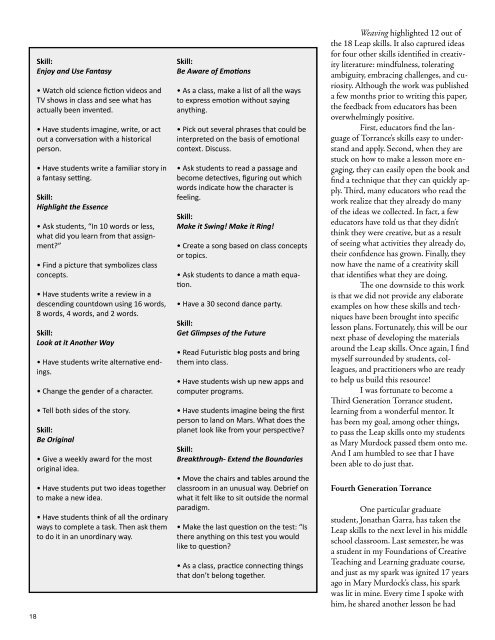Torrance Journal for Applied Creativity
TorranceJournal_V1
TorranceJournal_V1
Create successful ePaper yourself
Turn your PDF publications into a flip-book with our unique Google optimized e-Paper software.
18<br />
Skill:<br />
Enjoy and Use Fantasy<br />
• Watch old science fiction videos and<br />
TV shows in class and see what has<br />
actually been invented.<br />
• Have students imagine, write, or act<br />
out a conversation with a historical<br />
person.<br />
• Have students write a familiar story in<br />
a fantasy setting.<br />
Skill:<br />
Highlight the Essence<br />
• Ask students, “In 10 words or less,<br />
what did you learn from that assignment?”<br />
• Find a picture that symbolizes class<br />
concepts.<br />
• Have students write a review in a<br />
descending countdown using 16 words,<br />
8 words, 4 words, and 2 words.<br />
Skill:<br />
Look at it Another Way<br />
• Have students write alternative endings.<br />
• Change the gender of a character.<br />
• Tell both sides of the story.<br />
Skill:<br />
Be Original<br />
• Give a weekly award <strong>for</strong> the most<br />
original idea.<br />
• Have students put two ideas together<br />
to make a new idea.<br />
• Have students think of all the ordinary<br />
ways to complete a task. Then ask them<br />
to do it in an unordinary way.<br />
Skill:<br />
Be Aware of Emotions<br />
• As a class, make a list of all the ways<br />
to express emotion without saying<br />
anything.<br />
• Pick out several phrases that could be<br />
interpreted on the basis of emotional<br />
context. Discuss.<br />
• Ask students to read a passage and<br />
become detectives, figuring out which<br />
words indicate how the character is<br />
feeling.<br />
Skill:<br />
Make it Swing! Make it Ring!<br />
• Create a song based on class concepts<br />
or topics.<br />
• Ask students to dance a math equation.<br />
• Have a 30 second dance party.<br />
Skill:<br />
Get Glimpses of the Future<br />
• Read Futuristic blog posts and bring<br />
them into class.<br />
• Have students wish up new apps and<br />
computer programs.<br />
• Have students imagine being the first<br />
person to land on Mars. What does the<br />
planet look like from your perspective?<br />
Skill:<br />
Breakthrough- Extend the Boundaries<br />
• Move the chairs and tables around the<br />
classroom in an unusual way. Debrief on<br />
what it felt like to sit outside the normal<br />
paradigm.<br />
• Make the last question on the test: “Is<br />
there anything on this test you would<br />
like to question?<br />
• As a class, practice connecting things<br />
that don’t belong together.<br />
Weaving highlighted 12 out of<br />
the 18 Leap skills. It also captured ideas<br />
<strong>for</strong> four other skills identified in creativity<br />
literature: mindfulness, tolerating<br />
ambiguity, embracing challenges, and curiosity.<br />
Although the work was published<br />
a few months prior to writing this paper,<br />
the feedback from educators has been<br />
overwhelmingly positive.<br />
First, educators find the language<br />
of <strong>Torrance</strong>’s skills easy to understand<br />
and apply. Second, when they are<br />
stuck on how to make a lesson more engaging,<br />
they can easily open the book and<br />
find a technique that they can quickly apply.<br />
Third, many educators who read the<br />
work realize that they already do many<br />
of the ideas we collected. In fact, a few<br />
educators have told us that they didn’t<br />
think they were creative, but as a result<br />
of seeing what activities they already do,<br />
their confidence has grown. Finally, they<br />
now have the name of a creativity skill<br />
that identifies what they are doing.<br />
The one downside to this work<br />
is that we did not provide any elaborate<br />
examples on how these skills and techniques<br />
have been brought into specific<br />
lesson plans. Fortunately, this will be our<br />
next phase of developing the materials<br />
around the Leap skills. Once again, I find<br />
myself surrounded by students, colleagues,<br />
and practitioners who are ready<br />
to help us build this resource!<br />
I was <strong>for</strong>tunate to become a<br />
Third Generation <strong>Torrance</strong> student,<br />
learning from a wonderful mentor. It<br />
has been my goal, among other things,<br />
to pass the Leap skills onto my students<br />
as Mary Murdock passed them onto me.<br />
And I am humbled to see that I have<br />
been able to do just that.<br />
Fourth Generation <strong>Torrance</strong><br />
One particular graduate<br />
student, Jonathan Garra, has taken the<br />
Leap skills to the next level in his middle<br />
school classroom. Last semester, he was<br />
a student in my Foundations of Creative<br />
Teaching and Learning graduate course,<br />
and just as my spark was ignited 17 years<br />
ago in Mary Murdock’s class, his spark<br />
was lit in mine. Every time I spoke with<br />
him, he shared another lesson he had


